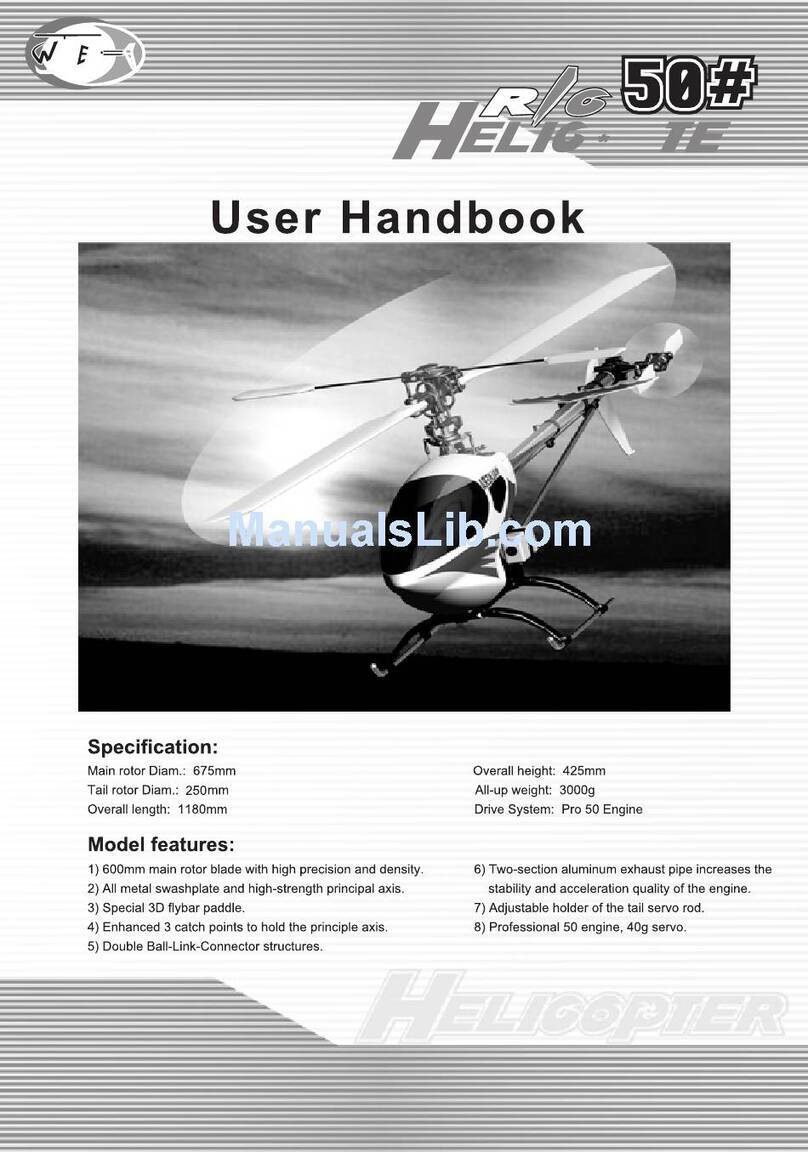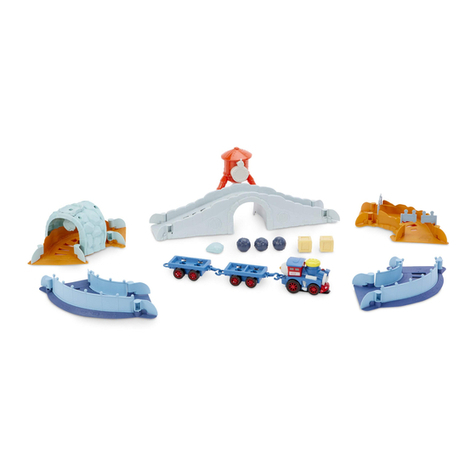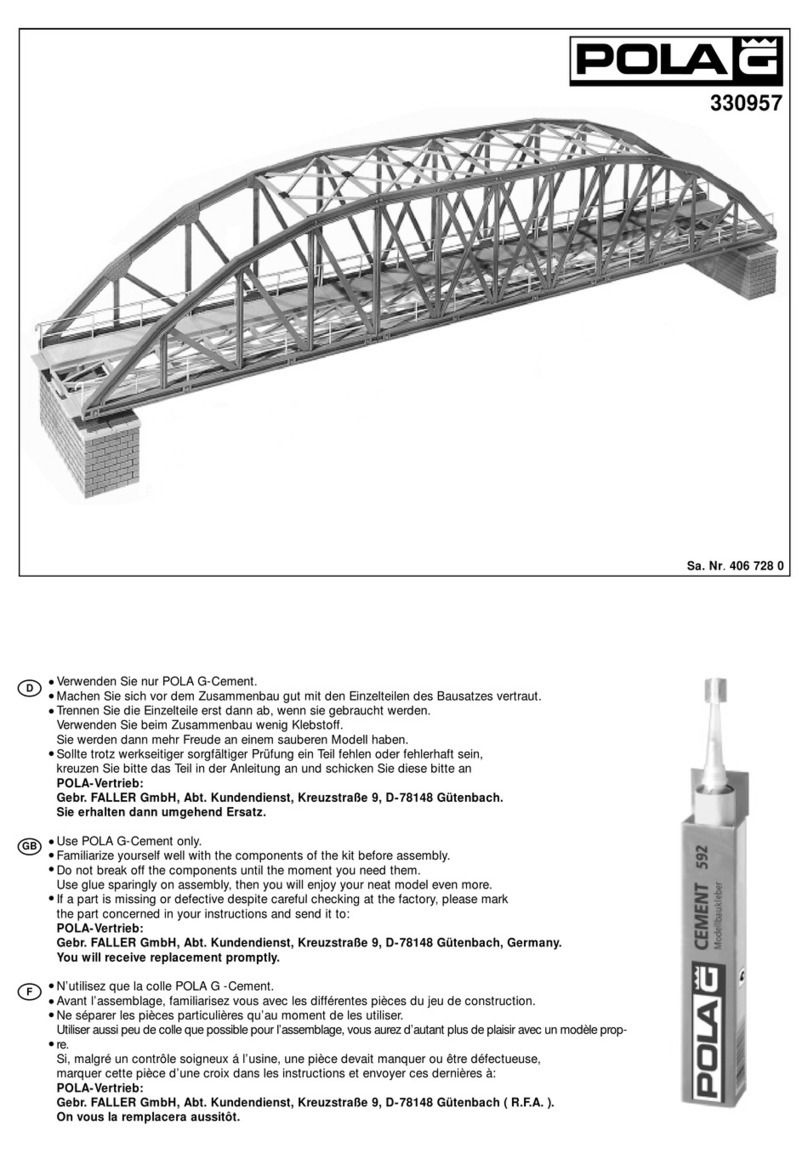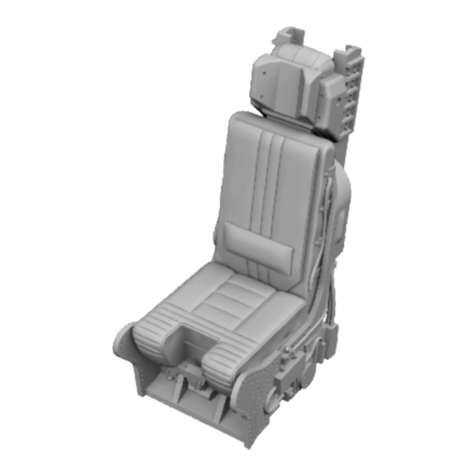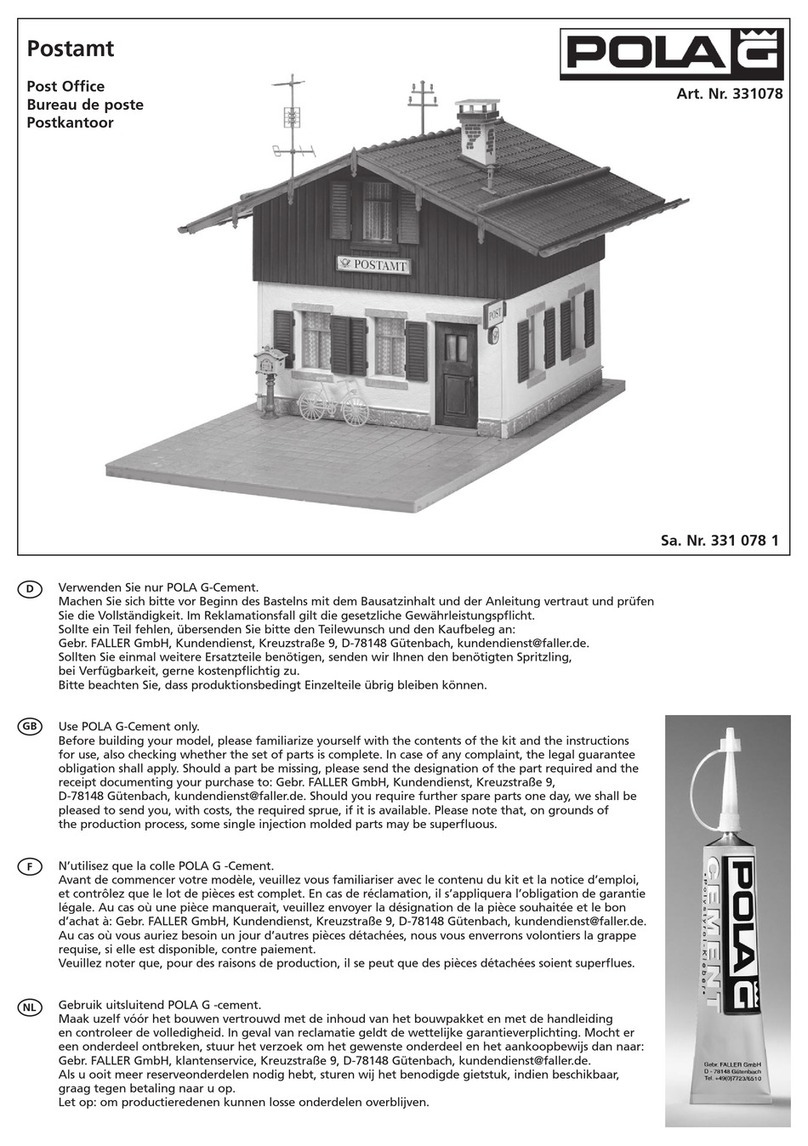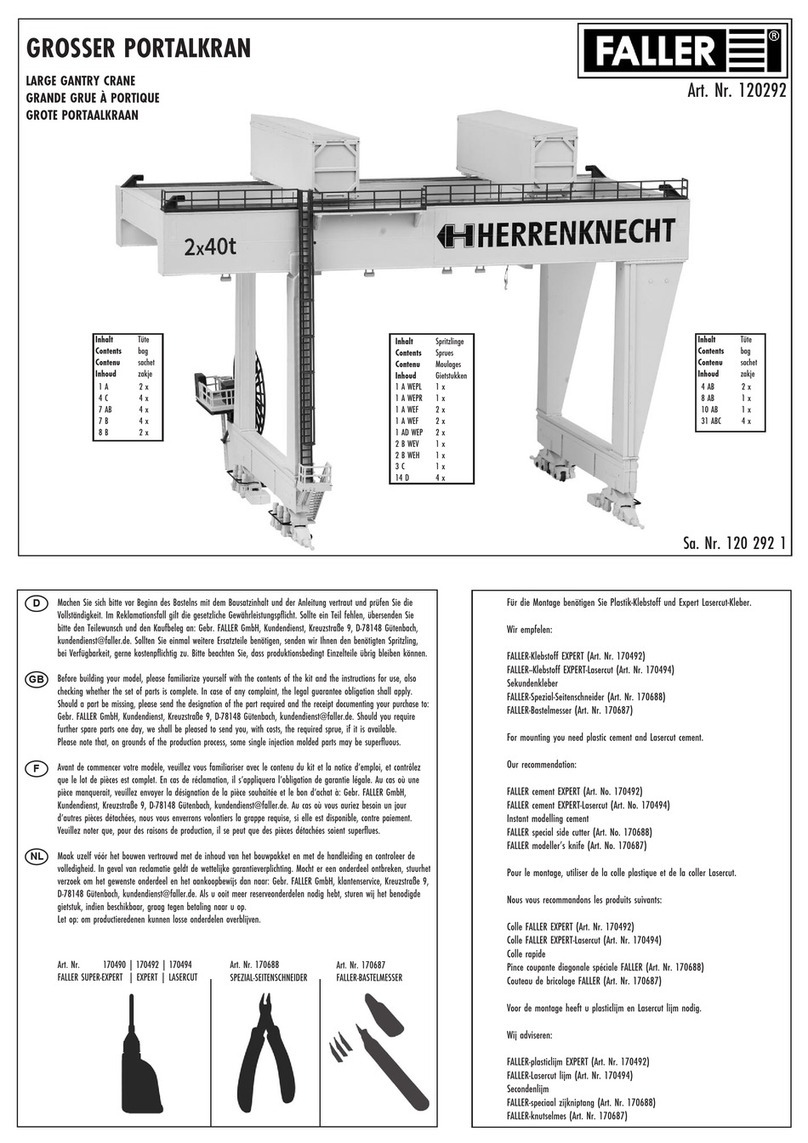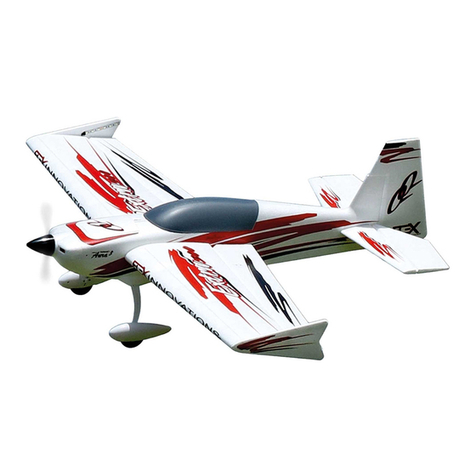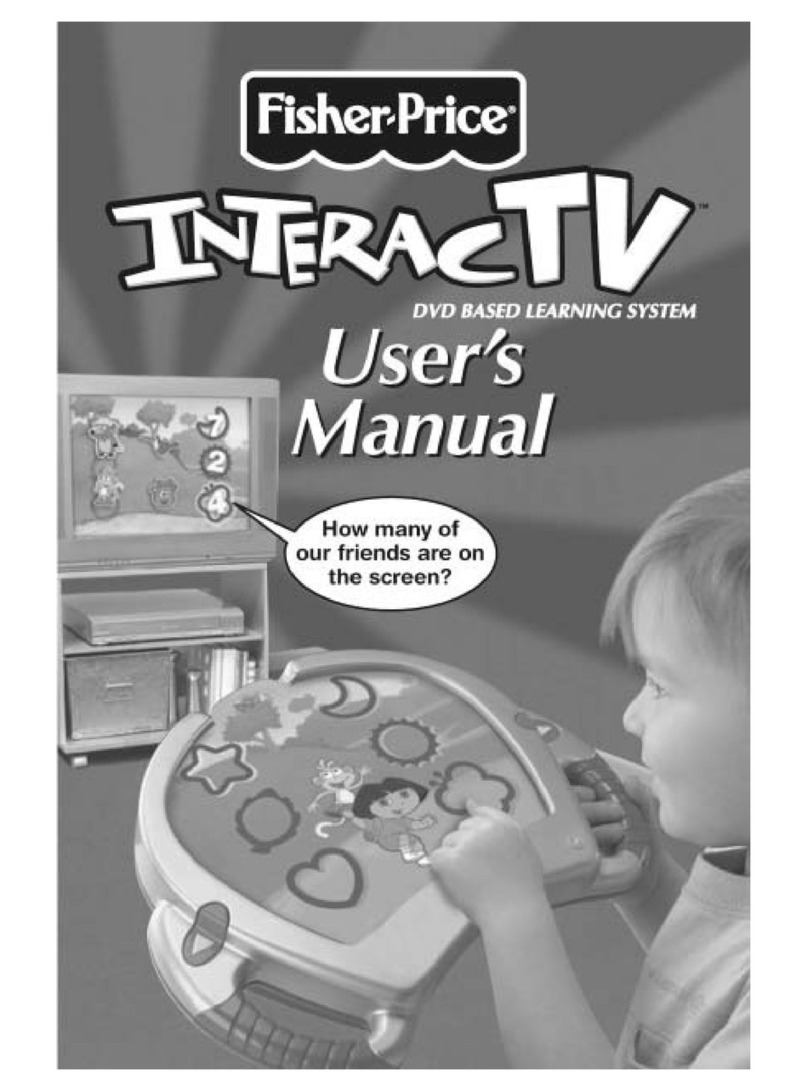Robotronics Buzz E. Smoke Alarm & Safety House User manual

i
Buzz E. Smoke Alarm & Safety House™
®
Operating Manual
Version 2.3

ii
Buzz E. Smoke Alarm and his House of Hazards™
Operating Manual
Congratulations on your purchase of a ROBOTRONICS, Inc. Smoke
Alarm with House of Hazards. Your house and robot have been carefully
constructed of the highest quality components. Its design is the result of years of
experience building safety education products. You will find it an extremely
effective educational tool for your organization. It is built for ease of operation,
maintenance and repair. It is built so that you can easily expand its functions
making its usefulness grow as your needs grow.
Please read this manual carefully. It will help you make the most of your
Smoke Alarm and House. Attention to maintenance will greatly prolong the life of
this product. Most problems you encounter will be minor and the manual will
provide an answer. Please feel free to contact us if you have unanswered questions
relating to operation, maintenance, and repair. Also, if you have technical
questions relating to expanding the functions of the House or Smoke Alarm, we
would be very happy to help.
Sincerely,
ROBOTRONICS, Inc.
ROBOTRONICS INC.
Springville, Utah 84663
www.Robotronics.com
©Robotronics Inc., 2000.
All Rights Reserved.
Printed in USA

iiiContents
Contents
Warranty Information.......................................................................................... 1
PART 1 General Operating Instructions..................................... 3
Chapter 1 Getting Started...........................................................3
Operating Hints ......................................................................................... 3
Setup and How To Operate ...................................................................... 4
Transporting.............................................................................................. 5
PART 2 Subsystems of the Smoke Alarm & House.............. 6
Chapter 2 Automatic Music Control System.............................6
Chapter 3 Smoke Alarm Character ............................................7
Chapter 4 The House with Lights..........................................9,10
Chapter 5 MP3/CD Player.....................................................11-13
Chapter 6 Power Supply...........................................................14
PART 3 Optional Features................................................................ 15
Chapter 7 Control Box ..............................................................15
Chapter 8 Voice System – Headset Microphone.....................16
Chapter 9 Video Camera and Monitor......................................... 17
Chapter 10 Voice Modifier ..........................................................18
Chapter 11 Battery Option..........................................................20
Battery Charger.............................................................................22
PART 4 Maintenance........................................................................... 23
Chapter 12 Maintenance ...........................................................23
Regular Maintenance Checklist .............................................................. 23
Painting of the Body................................................................................ 25
Repair of the Body .................................................................................. 26
Storage.................................................................................................... 27

iv Contents
Appendixes
Appendix A Program Modules Songs and Dialog...................28
Safety at Home..............................................................................29
Escape Plans.................................................................................34
Smoke Alarm Maintenance............................................................39
Don’t Play with Matches and Lighters..........................................44
Call 911 .........................................................................................49
Holiday Hazards............................................................................54
Appendix B Robot Parts Identification.....................................60
Smoke Alarm Inside View....................................................................... 61
Smoke Alarm Back View......................................................................... 62
Servo Board ......................................................................................... 63
Base Unit Electronics.............................................................................. 64
House Back Inside View ......................................................................... 65
Switching Output Boards......................................................................... 66
Operator Control Box Inside.................................................................... 67
Control Box Audio Board......................................................................... 68
Fuse Block Detail.................................................................................... 69
Notes Section*.................................................................................................... 70
Technical Tips Section* ...................................................................................... 71
* These sections can be used to place additional notes that you would like to record, during
your use of the House or additional information sent from Robotronics.

1
Warranty Information and Getting Help
LIMITED WARRANTY
All Robotronics products have a limited one year warranty which covers all parts and labor.
This period covers the normal burn-in for electronic components. Experience has shown that
this warranty period catches most component defects and other possible flaws.
If you have a problem, we are anxious to help. Our desire is to be certain you receive a quality
product and excellent service.
Warranty work is specifically limited to correction of defects by repair or replacement of faulty
equipment or parts. The product shall be repaired or replaced at Robotronics’ option.
Equipment returned to the factory for repair must be sent freight pre-paid, and will be returned
freight pre-paid by UPS ground or common carrier.
For international shipments, you will be responsible for paying customs duties, taxes and other
fees. The shipment must be labeled on the paperwork and on the outside of the container that
it is “For Educational Purposes”. If it is a “warranty replacement” or a “repair return” this
also must be indicated both ways on the customs documentation. Contact your customs
agency on how to document the shipment correctly to avoid unnecessary customs charges. If
you need parts sent by air shipment you will be responsible to pay the additional shipping
charges.
The buyer is further responsible to ensure that proper and complete training be given to those
operating the robot system as all aspects of such operation cannot be covered in a brief manual
such as this.
In no event shall ROBOTRONICS, Inc. be liable for any incidental or consequential damages in
connection with or arising from the use of this product or arising from the use of this manual or
any procedures contained herein.
If You Have A Problem
1. Call our service department and explain the problem. The phone number is (801) 489-
4466. Most difficulties are minor and can be solved easily over the phone. If possible,
have the robot near the phone when you call.
Important: Have the robot serial number and model number ready. This will help our
technician identify the model of robot you have. The serial and model number sticker is located
on the back of the house and base unit.
2. If you must return a portion or all of the House of Hazards for repair, pack it carefully and
send it prepaid.
3. Parts of the robot are best sent by a carrier such as UPS, or U.S. mail. Be sure to insure
the shipment for the correct value.
4.
5. For international shipments, you will be responsible for paying customs duties, taxes and
other fees. The shipment must be labeled on the paperwork and on the outside of the
container that it is “For Educational Purposes”. If it is a “warranty replacement” or a
“repair return” this also must be indicated both ways on the customs documentation.

2 Warranty Information and Getting Help
Contact your customs agency on how to document the shipment correctly to avoid
unnecessary customs charges.
After The Warranty Repair and Help
Our technical staff is always available to help with your questions. Again, most problems are
easily solved. If you do need replacement parts, we can usually ship them the following day you
call. Please call our service department before sending a part or your robot in for repair or
modifications.
Because of parts availability, robots may vary slightly from unit to unit. If you have any
questions, please contact our service department. The service department phone number is:
(801) 489-4466.

3
Chapter 1 Getting Started: Operating Hints
Part 1 General Operating Instructions
CHAPTER 1 Getting Started
DESCRIPTION OF FEATURES AND OPERATING HINTS
Robotronics’ new animated Buzz E. Smoke Alarm & House of Safety are unique and exciting
tools for teaching fire prevention and life-safety education. In the hands of a skilled and trained
operator, Buzz can be very effective in getting your safety messages across to children and
adults.
There are more than one version of the system. All versions have the animated Smoke Alarm
character with moving eyes, eyelids, eyebrows, and arms. All versions also have the
Automatic Music Control System. The system with control box enables the operator to
manually initiate all of the functions of both the smoke alarm and the house. A headset
microphone with a two-way voice system allows you to communicate through the smoke alarm.
A voice modifier is also available which allows you to disguise the sound of your voice. This
manual covers all of the system versions. The control box and the Safety House are not
included in all systems but can be purchased at any time.
In automatic mode, the Smoke Alarm has a personality of his own. In manual mode you can
add a personal touch to the character as you interact with your audience. Much of the
excitement of the Smoke Alarm is provided by the operator. Even an operator with a shy
personality can be effective with the smoke alarm as they get into the character and interact
with the children.
It’s best to have a firefighter facilitator interact with Buzz and get children involved in the
program. Bringing children up out of the audience to talk to Buzz and go over safety principles
helps re-enforce the learning process. Be prepared with the highlights of the safety rules and
concepts that you want the children to learn. It is best to mix some music with a lot of
interaction between Buzz, the instructor and the audience. Children seem to have more fun
and learn more when there is a lot of interaction in the form of audience participation and
questions.
The most important ingredient to the use and effective operation of the Smoke Alarm system is
common sense. The following instructions will help you get set up and start using it in a very
short time.

4 Chapter 1 Getting Started: Setup and How to Operate the Robot
SETUP AND HOW TO OPERATE
Step # 1 Read the manual
For connecting the wiring, follow the letters and description labels on the wiring and
components of the system.
Step # 2 Attach the Smoke Alarm on the base unit
The Smoke Alarm usually comes attached to the base unit already. If you need to connect it,
this is how.
1. Connect the Smoke Alarm control wires to the base unit. These are two wires coming up
through the hole on the base. Match these wires with the same colors coming out of the
Smoke Alarm. One is Blue/Orange/Yellow and the other is Green/White.
2. Set the Smoke Alarm in position over the holes in the base.
3. With the Smoke Alarm in position on top of the base unit, Screw the two screw knobs into
the bottom of the Alarm to secure it.
Note: If you have the Smoke Alarm Standard Model, you can go to step 4 powering up and
step 5 running Buzz on automatic mode.
Step # 3 Fold out the House of Hazards
1. Open the two side latches and open the House on a table.
2. Remove the front panels by lifting up to clear the bottom metal catches and then pull the
bottom out. To install the panels put the top up and in first and then lower the bottom metal
catches in at the bottom. You can see the slots in the plastic at the bottom of the opening.
3. Install the chimney on the top of the House.
Connecting the extension wires (depends on the package that you have)
1. Smoke Alarm only- no extension cables are needed.
2. Smoke Alarm and controls only- One extension cable from the control box to base unit.
3. Smoke Alarm and House- Connect the extension cable from the base unit to the House in
the back.
4. Smoke Alarm, House and Controls- Two extension cables are used; base to House and
control box to base unit.
Step # 4 Powering Up
1. Connect the power supply Red/Black wire to the Red/Black connector on the back of the
base unit.
2. Connect the power supply AC cord to a 110 Volt AC outlet.
3. Turn the power supply on.
4. When you are ready to turn it on, turn on the switch at the back of the Smoke Alarm base
unit. This powers up the entire system.
Step # 5 Running the Smoke Alarm and House on Automatic Mode:
1. Connect the MP3 player audio cable.
Models with a control box: Connect to the audio jack of the control box (Velcro on box).
Models w/out a control box: Connect to the audio jack on the base unit (Velcro on base).
2. Insert the programmed CD into the CD player or turn on the MP3 player.
3. To run the House on automatic mode, press play on the CD/MP3 player.
4. The House and Smoke Alarm will go through a program of songs. You can run it from one
track to the next continuously or you can select tracks.

5
Chapter 1 Getting Started: Transporting
5. Set the volume levels. There is a volume on the back of the Smoke Alarm base unit and
volume controls on the operator control box for the music/Smoke Alarm voice and headset
hearing levels. If you have a MP3 player, set the volume at the maximum level, then you
can adjust the master volumes where you want them.
Step # 6 Running the Smoke Alarm and House with a separate control box and extension
wire (optional feature):
1. Attach the extension wire to the back of the operator control box. There is a round
connector on the back of the Smoke Alarm base unit to connect to. Put the two connectors
together, rotate the connector until it sits into the mating connector and then twist the ring
until it stops.
2. With the control box option you can operate the house automatic or manually. For
automatic operation, just press play on the MP3 Player that has the programmed music on
it. If you buy additional modules later, you will need to load the music on your MP3 player
from a CD. For manual operation use the switches of the control box to operate the Smoke
Alarm and lights of the House. The headset microphone will allow you to be the voice of the
Smoke Alarm and also hear children talking to you.
3. Video Monitor Option: There is a video cable and power wire that comes with the monitor.
The power wire plugs in to the back of the control box and then to the DC in jack on the
monitor. The video plug is yellow and it runs from the control box to the video in of the
monitor.
4. Set the volume levels. There is volume level for the music and the Smoke Alarm’s voice
on the operator control box. There is also a volume on this same box for the volume of your
hearing in the headset.
Step # 7 Test all the functions
Test all of the functions of the House and Smoke Alarm: For the Smoke Alarm, test the eyelids,
eyes left and right, eyebrows, arms, and mouth movement. For the House, check the room
lights, Smoke Alarm LEDs, and danger LEDs. You are now ready to operate the House and
Smoke Alarm.
On a new system, the house will have a plastic protective covering over the color panels.
You may remove this now.
Step # 8 Powering Down: Turn off the main power switch, power supply and the MP3 player
TRANSPORTING
¾Remove the chimney from the top of the house. It is held on by velcro.
¾You can leave the Smoke Alarm on the base unit if you want. If you have removed the
cover, attach this to better protect the Smoke Alarm.
¾Make sure the latches on the side of the House are secure before transporting.
¾Disconnect the extension wire from the back of the house.
¾Put the front house panels back on.
¾Put the House in the canvas carrier to protect it from scratching or damage.
¾Put all other accessories in the canvas carry bags.
¾Do not allow anything sharp or hard to push against the room panels.
¾Protect the plastic cover from getting scratched.

6 Part 2 Subsystems of the Smoke Alarm & House of Hazards
Part 2 Subsystems of the House of Hazards
Functionally, the House of Hazards with Smoke Alarm is made up of the following basic
subsystems and features:
1. Automatic Music Control System
2. Smoke Alarm Character with Moving Mouth, Eyes, Eyelids, Eyebrows, and Arms.
3. The House of Hazards: Room lights, Smoke Alarm LEDs and hazard LEDs
4. MP3 or CD Player
5. Power Supply
Optional Features
6. Control Box
7. Voice System – Headset Microphone
8. Video Camera and Monitor
9. Voice Modifier
The systems block diagram found in the Appendix, shows how the various subsystems and their
components are interrelated. Following are explanations of each subsystem, some operating
instructions, and trouble shooting hints where appropriate.
Chapter 2 Automatic Music Control System
Automatic Music Control is the automatic operation of the House and Smoke Alarm from the
MP3 player. One of the tracks on the player is coded with commands that are synchronized
with the music. When the music is played, the main control board in the Smoke Alarm Base
Unit decodes commands on the tracks. These command signals are sent to the Smoke Alarm
and the lights in the House to create a synchronized performance with music and animation.

7
Chapter 3 Smoke Alarm Character
Chapter 3 Buzz E. Smoke Alarm
The Smoke Alarm has moving eyes, eyelids, arms, eyebrows, and a moving mouth. These
functions are operated by individual servo motors in the Smoke Alarm itself. The signal comes
from the main control board to operate these functions. The signal wire that comes from the
main control board goes to a servo board inside the Smoke Alarm. The servo board decodes
the pulse train signal into individual signals for each servo motor. The mouth servo is located in
the Smoke Alarm with a rod going up to the mouth itself. The mouth motor moves in sync to the
music or in sync to your talking if you are using the headset microphone.
When you put the Smoke Alarm on top of the base unit you have to screw in the round knobs to
his feet. Always make sure these are snug before operating. The two wires coming from Buzz
connect to two wires in the base unit. The wires are color coded to make it easy to match them
up. Be careful with these wires and connectors when removing or installing the Smoke Alarm.
Be especially careful with the arms when transporting Buzz.
Smoke Alarm Connector
and Wire

8 Chapter 3 Smoke Alarm Character
Care of the Plastic Cover for the Smoke Alarm
•The cover is made of ABS plastic and needs to be cleaned with mild soap and water with a
soft cloth.
•Windex or water and a soft cloth can be used.
•Do not use solvents or abrasive cleaners.
•When transporting the Smoke Alarm on the base, keep it secure so that it does not bounce
around.
•Put a cover or a blanket over it to protect it.
•Do not put it in the back of an open truck or trailer.
Microphone
Cover Latch Cover Latch
Note: The Actual Cover Is Solid Black ABS Plastic

9
Chapter 4 The House with Lights
Chapter 4 The House with Lights
The House lighting system is made up of two main light types; the room panel lights and the
LED lights. The LED lights are used for the smoke alarms in each room and to indicate the
hazards. The room lights have a switch and the LEDs in a room has a switch.
When you hit a switch on the control panel, this input is picked up by the control panel main
board and sent along the wire to the main board in the House. This signals the correct
switching output to turn on the room light or hazard LED. There are connectors going from
each light to the switching outputs.
How to remove the front panel in order to change a color panel, room bulb, or hazard LED:
1. To do this, find the dowel velcroed on the back of the house. Insert the dowel into the hole
in the back cover of the house. Push on the dowel and this will flex out on the front panel(s)
so that you can get your hand behind it. Next, slide the top of the panel down to release it
from the top slots.
2. The other way is to remove the back cover of the house, push down the tabs of the front
panel, and flex out the panel. Look up in the back of the house and you will see these tabs.
Push down on them and the panel will flex on the front. While you are pushing down, have
someone in the front pull out the flexed panel at the top.
Room Light Bulb
Hazard LEDs
Changing to a different color panel:
After releasing the top of the clear panel, open it enough to get the color panel out and slide the
new color panel in. Flex the clear panel enough to pop the tabs back up into the slots.
Chapter 4 The House with Lights

10
Changing a room light bulb:
1. Remove the front panels enough to get to the bulb.
2. Replace the bulb in the socket and make sure the new bulb is screwed in tight.
3. To put the panel back in, flex it and pop it in to the slots.
How to change a LED hazard light:
The Super Bright light emitting diodes should last for a very long time. But if necessary to
change the red LED lights it is best to go in through the front panel because these lights are
glued on a clear sheet of plastic behind the room graphic color panel. There are three sheets of
plastic on the front of the house; the clear front panel, the color panel, and the LED panel.
The LED panel has clear tubes that hold the LEDs.
1. Remove the front panel as instructed above. Now you will have access to the LED panel
and you can remove the LED that is burnt out. Important: Only pull the LED panel out
enough to get to the LED that you need to replace because if you pull it too far then
many of the wires going to the LEDs will pop off and you will have to put them back
on.
2. Pull the brown connection off of the LED. Note that the LED has a long lead and short
because it is polarized.
Note: The connector has yellow on the long lead of the LED, and blue on the short.
3. Pull the LED out of the clear tube carefully to avoid popping the tube off the panel.
4. Replace the LED and put a little hot glue on it to hold it in. Connect the brown connector:
LED Long Lead - Yellow wire
LED Short Lead - Blue wire
5. You can give the leads a little bend to keep the connector from slipping off.
6. Pop the front panel tabs back in and screw the back cover on.
You can get replacement bulbs and LEDs from Robotronics. You can get the LEDs with or
without the yellow/blue wire going back to the circuit board.

11
Chapter 5 CD Player Instructions
Chapter 5 CD or MP3 Player Operation and Maintenance
CD player
Pushing the CD Play/Pause button on the CD player activates the Compact Disc player.
How to Play A CD
1. Make sure that your power and audio wires are plugged into the CD player.
2. Slide the OPEN button to open the cover.
3. Insert the CD.
4. Press the play/pause button to play.
5. Selecting tracks- Use the double arrow right or left to search for tracks or go to the next
track.
6. If you are connected to the line out, the volume of the music is adjusted on the main volume
rather than on the CD player. If you are connected to the headphones adjust the CD player
volume.
Using Other Functions
ESP
The ESP (Electronic Shock Protection) function minimize skipping by using a buffer memory
that stores music data and plays it back in the event of a shock. When this is on ESP shows up
on the display. If it does not show up in the display, push the ESP button. If you are in ESP
when you turn off the CD player, it will remain on ESP when you turn it back on.
Hold Feature
To activate, push the HOLD slide button. This locks the player against accidental pushing of the
buttons on the front of the player. The pushbutton palm control will still be active. The word
HOLD will appear in the display. To unlock, slide HOLD back.
Maintenance and Care
¾Clean the lens with a lens cleaning kit such as KK-DM1.
¾To clean the casing use a soft cloth slightly moistened in water or a mild detergent solution.
Do not use alcohol, benzene or thinner.
¾Keep the lens on the player clean and do not touch it. If you do so, the lens may be
damaged and the player will not operate properly.
¾Do not put any heavy object on top of the player or the player and the CD may be damaged.
¾Do not leave the player in a location near heat sources, or in a place subject to direct
sunlight, excessive dust or sand, moisture, rain, mechanical shock, unleveled surface, or in
a car with its windows closed.

12 Chapter 5 CD Player Instructions

13
Chapter 5 MP3 Player Instructions
MP3 Player (See the MP3 operating manual)
1. Install a fresh battery in the MP3 player.
2. Make sure that the volume is turned up to maximum on the MP3 player for the movements
of Buzz to work with the music. You can adjust the master volume on the control box or
base unit to your desired volume coming out the speakers.
3. The Buzz songs are already installed on the MP3 player, but if you want to add additional
songs you will need to load them on the MP3 player through a computer. There is a copy of
the MP3 files on a CD in case you need to load them again in the future.
4. Install the software from the CD on your computer if you want to download additional songs
to the player.
5. Make sure the lock switch is off which locks the controls.
6. Press and hold the play button. Select the music menu and select a track.
7. Start the track with the play button. You can pause with this same button.
8. Use the stop (box symbol) button for stop. Press and hold for shut down of the player.
Auto Shutoff Feature
The auto shutoff feature shuts off the MP3 player if not in use for a designated amount of time.
You can change this from 1 minute to 60 minutes. Just go in to the settings menu, auto
shutdown. We recommend a setting of at least 25 minutes so that it does not shut off while you
are doing a program.

14 Chapter 6 Power Supply Use
Chapter 6 Power Supply
The power for the system is supplied by a power supply or a battery. The House comes
with a power supply that is rated at 13.8 Volts 10 Amps. There is an optional battery and
battery charger you can obtain if you think you will be in locations that will not have 110 Volt
outlets available. The battery is a 12 Volt 33AH Gel type battery. Either the power supply or
battery connect into the same connection on the back of the house. This is the black/red
connection. Line up the red to red and black to black. This is a polarized connection and can
only be connected one way. The polarity of the wires on the front of the supply must not
be disturbed. They must always be red wire to positive and black wire to negative post.
Binding Posts
Power plug that goes to
Smoke Alarm base unit

15
Chapter 7 Operator Control Box
Part 3 Optional Features
Chapter 7 Control Box
The control box allows the operator to use the House and Smoke Alarm in manual mode. The
operator can turn on the room lights, smoke alarm lights or hazard lights individually to
emphasize the dangers in certain rooms and do a walk through of the entire house, room by
room. The operator can also operate all of the functionality of the Smoke Alarm and interact
with the audience. With the headset–microphone you can be the voice of the Smoke Alarm and
hear what the kids are saying.
After a switch is hit on the control box this input goes to the control board in the control box.
This board communicates with the control board in the House, which operates the specific
function that you have selected.
Smoke Alarm
Controls
MP3 Player
Smoke Alarm & Music
Volumes
House Lights and
Hazard LEDs
Voice Modifier Controls
Hearing Volume
MP3 Audio
Headset 16 pin Connector
Video Connections

16 Chapter 8 Voice System
Chapter 8 Voice System
The Voice System allows you to be the voice and hearing of the Smoke Alarm. It includes a
headset microphone, audio board in the control box, and the audio board in the base unit.
When you talk into the microphone the signal goes first to the audio board in the control box
where it is mixed with the audio from the MP3 player and then sent to the audio board in the
House. The House audio board amplifies the signal to be put on the speakers. The master
volume controls this volume level along with the music. The hearing involves a microphone on
the Smoke Alarm, which picks up the kids voices and sends it from the House audio board to
the control box audio board and on to the headset speaker.
1/8 “ (3.5mm) headphones plug 3.5mm plug
Table of contents
Other Robotronics Toy manuals
Popular Toy manuals by other brands

LEGO
LEGO STAR WARS 75107 Assembly manual
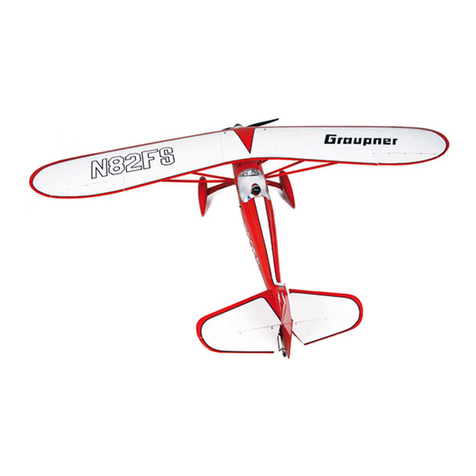
GRAUPNER
GRAUPNER STARLET 2400 instructions
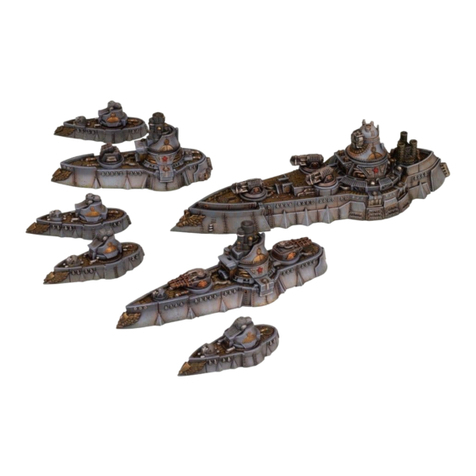
WARCRADLE STUDIOS
WARCRADLE STUDIOS Dystopian Wars BORODINO BATTLEFLEET Aassembly Instructions
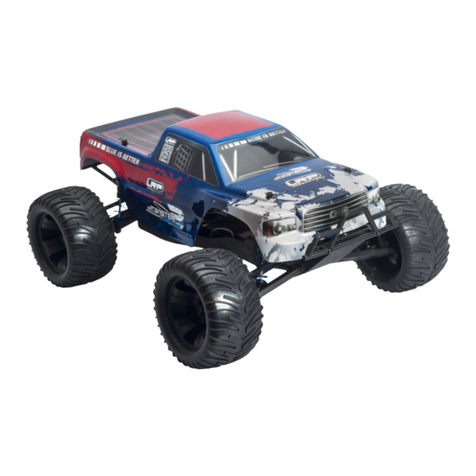
LRP
LRP S10 TWISTER MT 2 user guide

Hasbro
Hasbro Disney Princess Glitter Style instructions

LEGO
LEGO Juniors Jurassic World 10757 manual

